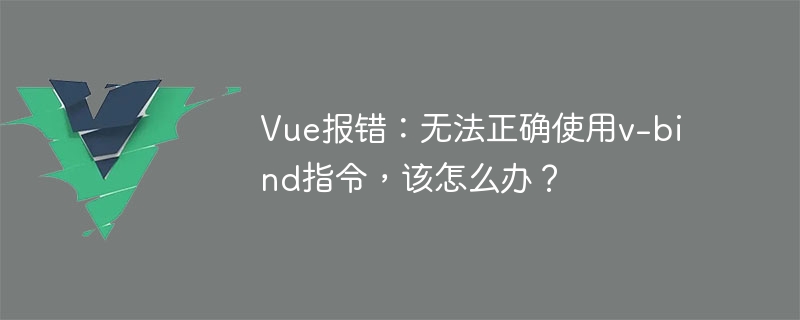Home >Web Front-end >Vue.js >Vue error: The v-bind directive cannot be used correctly, what should I do?
Vue error: The v-bind directive cannot be used correctly, what should I do?
- 王林Original
- 2023-08-17 18:12:221851browse

Vue error: The v-bind instruction cannot be used correctly, what should I do?
When using Vue to develop front-end applications, we often use the v-bind directive to dynamically bind property values. However, sometimes when we use v-bind, we may encounter some wrong situations that prevent the instruction from being used correctly. This article will introduce some common v-bind errors and provide corresponding solutions.
First, let’s look at a simple example, using the v-bind directive in the Vue template to bind a dynamic attribute to an input element:
<template>
<div>
<input type="text" v-bind:value="message">
</div>
</template>
<script>
export default {
data() {
return {
message: "Hello Vue!"
}
}
}
</script>In the above code, we use v- The bind directive binds the message attribute to the value attribute of the input element. In this way, when the message attribute changes, the value of the input element will be automatically updated.
However, when we run this code in the browser, we may encounter the following error message:
[Vue warn]: Cannot bind dynamic property 'value' because it is an unknown element. For fictionalized HTML content, use the 'is' syntax instead of rendering elements.
This error message tells us that the value attribute cannot be bound to an unknown on the elements. Although the input element is one of the elements we often use, in the Vue template, if the relevant components are not introduced correctly, Vue cannot recognize the element.
The way to solve this problem is to register the relevant components in the component options of the Vue instance. In the above example, we need to introduce Vue's input component and register it with our Vue instance. The code is as follows:
<template>
<div>
<input type="text" v-bind:value="message">
</div>
</template>
<script>
import VueInput from 'vue-input';
export default {
components: {
'vue-input': VueInput
},
data() {
return {
message: "Hello Vue!"
}
}
}
</script>By introducing and registering related components, we can use the v-bind instruction smoothly and avoid this error.
In addition, there is a common situation that when we want to bind the properties of an object to multiple properties of an HTML element, there may be some problems using the v-bind syntax. question. In this case, Vue provides a more concise way of writing: use the : symbol instead of the v-bind directive.
For example, we want to bind an object containing multiple properties to a button. The code is as follows:
<template>
<div>
<button :style="{ color: textColor, backgroundColor: bgColor }">{{ buttonText }}</button>
</div>
</template>
<script>
export default {
data() {
return {
buttonText: "Click me",
textColor: "blue",
bgColor: "yellow"
}
}
}
</script>In the above code, we bind the textColor and bgColor properties Go to the style attribute of the button element. By using the : notation instead of the v-bind directive, we can achieve the same effect more concisely.
To sum up, the inability to use the v-bind directive correctly may be caused by not registering related components correctly or using incorrect syntax. During development, we should pay attention to these common errors and promptly refer to Vue official documentation or search for related issues to solve them. Only by mastering the correct use of the v-bind directive can we better develop Vue applications and avoid common mistakes.
The above is the detailed content of Vue error: The v-bind directive cannot be used correctly, what should I do?. For more information, please follow other related articles on the PHP Chinese website!

